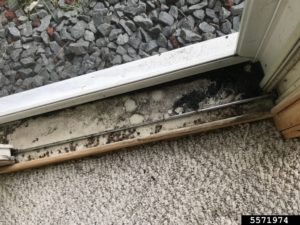
Seven spotted lady beetle on milkweed
It is that time of year when Asian Lady Beetles make an appearance indoors, and usually in large numbers. While they can be a major nuisance, they shouldn’t cause panic and some simple exclusion practices can help prevent this issue in the future.
Asian Lady Beetles are not native to Texas – they were introduced from Asia to the United States in 1960s and 1990s as a UDSA project to help reduce agricultural pests in several Southern and Eastern States from Louisiana to Connecticut. They are now found throughout the United States either from natural spread or from further introductions into the United States from Japan on freighters.
Asian Lady Beetles are a true lady beetle, better known as a ladybug. They are wonderful biological control agents of pests such as aphids in nature and during warmer months, help control those pests in our landscape. During colder, winter months, they have a trait that makes them different from other ladybugs – their propensity to find harborage in protected spaces, which often is our warm home. One way to tell the difference between Asian Lady Beetles and other species is that these guys have a marking behind their head that looks like an M.

Asian Lady Beetles found in the window of a home
Asian Lady Beetles tend to be attracted to light or lit surfaces and will congregate in mass numbers on sunny, Southwest sides of buildings. Especially those structure that are lighter in coloration, but really any surface will do as long as it is warmed by the afternoon sun. They will soon find cracks and crevices to squeeze through and often times get into eaves of homes, attics, or directly indoors.
When we have these up and down temperatures in winter, typical of Texas, they will become active on the warmer days and are noticeable inside the home, clustering and flying around windows, door frames or lights.
The good news is that Asian Lady Beetles are not harmful to humans or pets. Even when consumed, they are not known to be toxic, although I imagine if a dog ate too many, it would get an upset stomach. But what they will do is leave a yellow stain on walls and surfaces, emit an musty odor, and just be a plain nuisance. You may love ladybugs outside in your garden, but who wants them indoors?
How do you get rid of them? Prevention is key, but it’s often times thought of too late. Seal up around cracks and crevices along windows and eaves, use screens on vents and large holes, replace weather stripping that is worn around door frames. For those already inside, vacuum them up! Throw them back outside and let them do their thing in nature.
Pesticide treatments are not always effective. It’s best not to focus on the indoors, but outside where they are entering. Where they are applied is key – put the pesticide where the ladybugs are entering…. but if you know where that is, seal it up! The entry points are usually vents, eaves, soffits, windows and doors. Apply synthetic pyrethroids, such as bifenthrin, lamda cyhalothrin, delatmethrin, or cyfluthrin. But if the ladybugs are already indoors, it’s too late to spray. In that case, pull out the vacuum.
OR – consider your house lucky! Ladybugs are considered a sign of luck after all!
Want to learn more check out our Unwanted Guests Podcast
Written by Molly Keck, Senior Extension Program Specialist